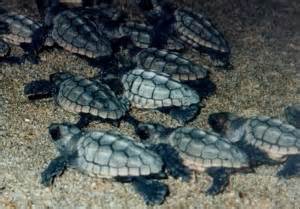
by Rick O'Connor | Feb 5, 2020
This is one of the most beloved animals on the planet… sea turtles. Discussions and debates over all sorts of local issues occur but when sea turtles enter the discussion, most agree – “we like sea turtles”, “we have nothing against sea turtles”. There are nonprofit groups, professional hospitals, and special rescue centers, devoted to helping them. I think everyone would agree, seeing one swimming near the shore, or nesting, is one of the most exciting things they will ever see. For folks visiting our beaches, seeing the white sand and emerald green waters is amazing, but it takes their visit to a whole other level if they encounter a sea turtle.
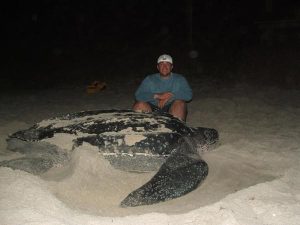
The largest of the sea turtles, the leatherback.
Photo: Dr. Andrew Colman
They are one of the older members of the living reptiles dating back 150 million years. Not only are they one of the largest members of the reptile group, they are some of the largest marine animals we encounter in the Gulf of Mexico.
There are five species of marine turtles in the Gulf represented by two families. The largest of them all is the giant leatherbacks (Dermochelys coriacea). This beast can reach 1000 pounds and have a carapace length of six feet. Their shell resembles a leatherjacket and does not have scales. Because of their large size, they can tolerate colder temperatures than other marine turtles and found all over the globe. They feed almost exclusively on jellyfish and often entangled in open ocean longlines. There is a problem distinguishing clear plastic bags from jellyfish and many are found dead on beaches after ingesting them. Like all sea turtles, they approach land during the summer evenings to lay their eggs above the high tide line. The eggs incubate within the nest for 65-75 days and sex determination is based on the temperature of the incubating eggs; warmer eggs producing females. Also, like other marine turtles, the hatchlings can be disoriented by artificial lighting or become trapped in human debris, or unnatural holes, on the beach. These animals are known to nest in Florida and they are currently listed as federally endangered and are completely protected.
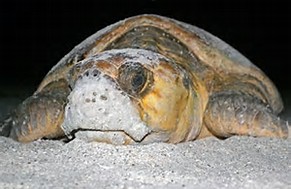
The large head of a loggerhead sea turtle.
Photo: UF IFAS
The other four species are found in the Family Chelonidae and have the characteristic scaled carapace. Much smaller than the leatherback, these are still big animals. The most common are the loggerhead sea turtles (Caretta caretta). As the name suggest, the head of this sea turtle is quite large. Their carapace can reach lengths of four feet and they can weigh up to 450 pounds. The head usually has four scutes between the eyes and three scutes along the bridge connecting the carapace to the plastron. This animal prefers to feed on a variety of invertebrates from clams, to crabs, to even horseshoe crabs. It too is an evening nester and the young have similar problems as the leatherback hatchlings. The tracks of the nesting turtle can be identified by the alternating pattern made by the flippers. One flipper first, then the next. The loggerhead is currently listed as a federally threatened species.
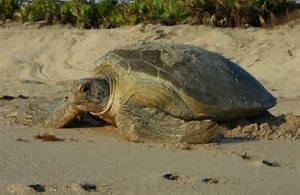
A green sea turtle on a Florida beach.
Photo: Florida Sea Grant
The green sea turtle (Chelonia mydas) is called so not for the color of its shell, but for the color of its internal body fat. They are fans of eating seagrasses, particularly “turtle grass” and other plants, which produce the green coloration of the fat. The fat is used to produce a world favorite, “turtle soup”, and has been a problem for the conservation of this species in some parts of the world. At one time, most green turtles nested in south Florida, but each year the number nesting in the north has increased. They can be distinguished from the loggerhead in that (1) their head is not as big, (2) there are only two scales between the eyes, and (3) their flipper pattern in sand is not alternating; green turtles throw both flippers forward at the same time. Green turtles are listed as federally threatened.
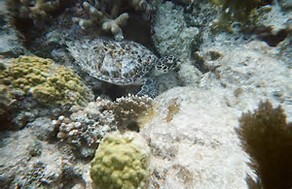
A hawksbill sea turtle resting on a coral reef in the Florida Keys.
Photo: Molly O’Connor
The hawksbill turtle (Eretmochelys imbricata) is more tropical in distribution. They are a bit smaller, with a carapace length of three feet and a weight of 187 pounds, but their diet of sponges is another reason you do not find them often in the northern Gulf of Mexico. To feed on these, they have a “hawks-bill” designed to rip the sponges from their anchorages. Their shell is gorgeous and prized in the jewelry trade. “Tortoise-shell” glasses and earrings are very popular.
The most endangered of them all is the small Kemp’s Ridley sea turtle (Lepidochelys kempii). This little guy has a carapace length of a little over two feet and weighs in at no more than 100 pounds. These guys are commonly seen in the Big Bend area of Florida but for years no one knew where they nested. That was until 1947 when an engineer from Mexico found them nesting in large numbers (up to 40,000) at one time, in broad daylight in Rancho Nuevo, Mexico. This was problematic for the turtle because the locals would wait for the nesting to be complete before they would take the females and the eggs. Protected today they now face the problem that their migratory path across the Gulf takes them through Texas and Louisiana shrimping grounds, and through the 2010 Deep Water Horizon oil spill field. Not to mention that illegal poaching still occurs. Though all species of sea turtles have had problem with shrimp trawls, the Kemps had a particular problem, which led to the develop of the now required Turtle Excluder Device (T.E.D.S) found on shrimp trawls in the U.S. today. Sea turtles have strong site fidelity for nesting and in the 1980s many Kemp’s Ridley eggs were re-located to beaches in Texas in hopes to move the nesting to other locations. The program had some success and they have been reported to nest in Florida. Their diet consists primarily of crabs but there have been reports of them removing bait from fishing lines fishing from piers over the Gulf. This is species is federally endangered and is considered by many to be the most endangered sea turtle species on the planet.
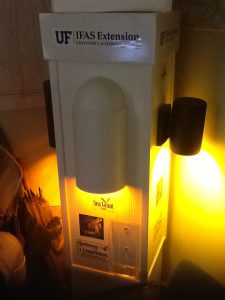
Turtle friendly lighting.
Photo: Rick O’Connor
Sea turtles face numerous human-caused problems including (1) artificial lighting that disorient hatchlings and cause mortality to 50% (or more) of the hatchlings, (2) items left on beaches (such as chairs, tents, etc.) that can impede adults and entrap hatchlings, (3) large holes dug on beaches in which hatchlings fall and cannot get out, (4) marine debris (such as plastics) which they confuse with prey and swallow, (5) boat strikes, sea turtles must surface to breath and can become easy targets, and (6) discarded fishing gear, in which they can become entangled and drown. These are simple things we can correct and protect these amazing Florida turtles.
References
Buhlmann, K., T. Tuberville, W. Gibbons. 2008. Turtles of the Southeast. University of Georgia Press, Athens GA. Pp. 252.
Florida’s Endangered and Threatened Species. 2018. Florida Fish and Wildlife Conservation Commission. https://myfwc.com/media/1945/threatend-endangered-species.pdf,
Species of Sea Turtle Found in Florida. Florida Fish and Wildlife Conservation Commission. https://myfwc.com/research/wildlife/sea-turtles/florida/species/.
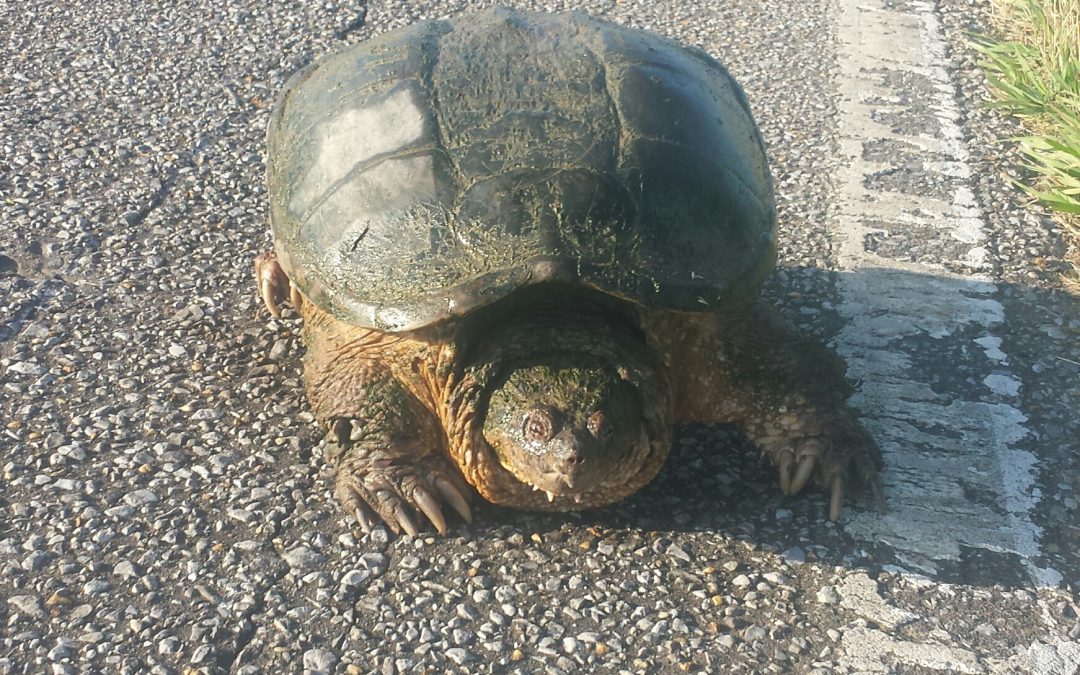
by Rick O'Connor | Jan 21, 2020
There are a couple of things you learn when working with youth in turtle education.
1) ALL turtles are snapping turtles
2) Snapping turtles are dangerous
I grew up in a sand hill area of Pensacola and we found box turtles all of the time. We had one as a “pet” and his name was “Snappy”. Oh, I forgot… all turtles are males.
That said, others are well aware of this unique species of turtle in our state. It does not look like your typical turtle. (1) They are large… can be very large – some male alligator snappers have weighed in at 165 lbs.! (2) Their plastron is greatly reduced, almost not there. Because of this their legs can bend closer to the ground and walk more like dogs than other turtles do. We call this cursorial locomotion. Snappers are not cursorial, but they are close, and because of this can move much faster across land. (3) Their carapace is almost square shaped (versus round or oval) and have large ridges making them look like dinosaurs. (4) They have longer tails than most turtles, some species have scales pointing vertically making them look even more like dinosaurs. Scientists have wondered whether this unique reduced plastron-better locomotion design was the original for turtles (and they lost it), or they are the “new kids on the block”. The evidence right now suggests they are “the new kids”.
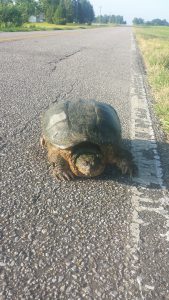
The relatively smooth shell of a common snapping turtle crossing a highway in NW Florida.
Photo: Libbie Johnson
And of course, there is the “SNAP”. These are very strong animals who seem to crouch and lunge as they quickly SNAP at potential predators – as quickly as 78 milliseconds/bite. I remember once stopping on a rural highway to get one out of the road. I grabbed it safely behind the nape and near the rear. That sucker crouched and snapped, and I could hardly hold on. I was amazed by its strength. It did not understand I was trying to help. You do need to be careful around these guys.
In Florida, we have two species of snapping turtles; the common and the alligator. They look very similar and are often confused (everyone seen is called an alligator snapper). There are couple of ways to tell them apart.
1) The alligator snapper has a large head with a hooked beak.
2) The alligator snapper’s carapace is slightly squarer and has three ridges of enlarged scales that make it look “spiked”; where the common snapper lacks these.
3) The tail of the common snapper has vertical “spiked” scales; which the alligator lacks.
4) And the textbook range of the alligator snapper is the Florida panhandle. Basically, if you are south or east of the Suwannee River, it should not be around – you are seeing the common.
As the name implies, the common snapper (Chelydra serpentina) is found throughout the state – except the Florida Keys. There are actually two subspecies; the Common (C. serpentia serpentina) which is found west of the Suwannee River and the Florida Snapper (C. serpentina osceola). This species uses a wide range of habitats. They have been found in small creeks, ponds, floodplain swamps, wet areas of pine flatwoods, and on golf courses.
These are very mobile turtles, often seen crossing highways looking for nesting locations, dispersing to new territory, or their pond has just dried up and they need a new one. Interestingly they have an expanded diet. Most think of snapping turtles as fish eaters, but common snappers are known to consume large amounts of aquatic plants and invertebrates.
Like all turtles, snappers must find high-dry ground for nesting. Nesting begins around April and runs through June. In south Florida, nesting can begin as early as February. They select a variety of habitats and typically lay 2-30 eggs deep in the substrate. These incubate for about 75 days and the temperature of the egg determines its sex; warmer eggs produce females. Nest predation is a problem for all turtles, snappers are not exempt from this. Raccoons are the big problem, but fish crows, fox, and possibly armadillos also dig up eggs. Many adults have been found with leeches. Turtles are known to live long lives. Data suggests common snappers reach 50 years of age.
Alligator snappers (Macrochelys temminckii) are the big boys of this group. Where the common snapper’s carapace can reach 1.5 feet, the alligator snapper can reach 2.0. (that’s JUST the shell). As mentioned, this animal is found in the Florida panhandle only. It is a river dweller and prefers those with access to the Gulf of Mexico. They appear to have some tolerance of brackish water. One alligator snapper near Mobile Bay AL had barnacles growing on it. Evidence suggest they do not move as much as common snappers and stay in the river systems where they were born. There are three distinct genetic groups: (1) the Suwannee group, (2) the Ochlocknee/Apalachicola/Choctawhatchee group, and (3) the Pensacola Bay group.
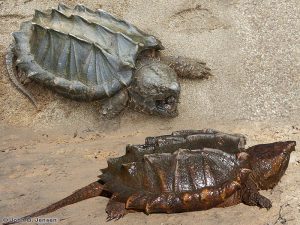
The ridged backs of the alligator snapping turtle. Photo: University of Florida
This animal is more nocturnal than their cousin and are not seen very often. They are basically carnivores and known to feed on fish, invertebrates, amphibians, birds, small mammals, reptiles, small alligators, and acorns are common in their guts. This species possesses a long tongue which they use as a fishing lure to attract prey.
Alligator snappers have a much shorter nesting season than most turtles; April to May. And, unlike other turtles, only lay one clutch of eggs per season. They typically lay between 17-52 eggs, sex determination is also controlled by the temperature of the incubating egg, and they may have strong site fidelity with nesting. Male alligators are very aggressive towards each other in captivity. This suggests strong territorial disputes occur in the wild. These live a bit longer than common snappers; reaching an age of 80 years.
Though still common, both species have seen declines in their populations in recent years. Dredge and fill projects have reduced habitat for the common snapper. Dams within the rivers and commercial harvest have impacted alligator snapper numbers. The alligator snapper is currently listed as an imperiled species in Florida and is a no-take animal (including eggs). Because the common snapper looks so similar, they are listed as a no-take species as well.
Both of these “dinosaur” looking creatures are amazing and we are lucky to have them in our backyards.
References
Meylan P.A. (Ed). 2006. Biology and Conservation of Florida Turtles. Chelonian Research Monographs No.3, 376 pp.
FWC – Freshwater Turtles
https://myfwc.com/wildlifehabitats/wildlife/freshwater-turtles/.
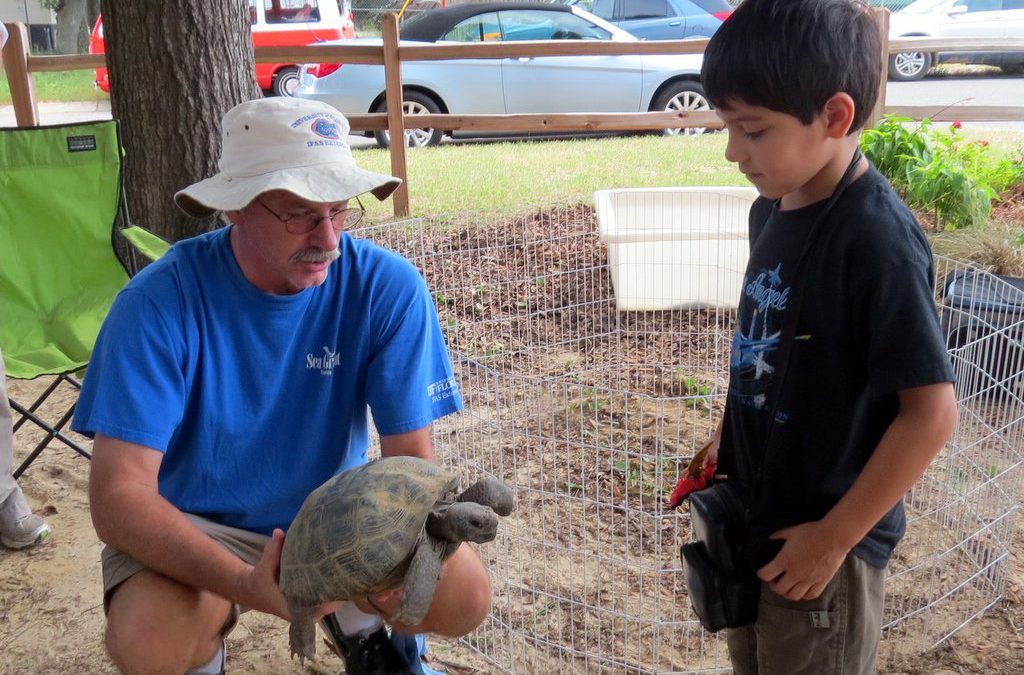
by Rick O'Connor | Jan 8, 2020
How cool, there is nothing wrong with other animals, but how cool for a year to be dedicated to turtles. And how fitting for the Florida panhandle. Based on the publication Biology and Conservation of Florida Turtles (2006), there are 38 taxa of turtles in our state. The majority of these can be found in the panhandle, particularly near the Apalachicola and Escambia Rivers. Within our state some species are only found at these two locations, and some are only found there on the planet.
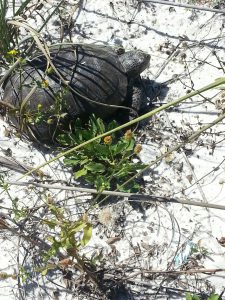
A terrestrial gopher tortoise crossing the sand on Pensacola Beach.
Photo: DJ Zemenick
Everyone loves turtles.
I hear a lot of stories about families trying to rescue while they are crossing highways. And when it comes to conservation, most will tell you “don’t mess with the turtles”. They are not kola bears… but they’re close. So, we are excited that 2020 is not only the year to Embrace the Gulf of Mexico, but also the Year of Turtle, and we plan to post one article a month highlighting the species richness of our area.
Let’s start with turtles in general.
Most know they are vertebrates but may not know the backbone and ribs support the framework for their famous shell. The top portion of this shell, where the backbone is, is called the carapace. The hard portion covering their chest area is the plastron. And they are connected by the bridge. The shell is a series of bony plates covered with scales (scutes). These scales are what put them in the class Reptilia. Fish also have scales but differ from reptiles in that they have gills instead of lungs. Most turtles are excellent swimmers, but they must hold their breath underwater, and some can do this for quite a long time.
All turtles are in the same Order Chelonia. The terms tortoise and terrapin are more cultural than biological. There are 7 families, and 25 species, of turtles found in Florida. Some are marine, and some terrestrial, but most are what we call “riverine”, living in freshwater.
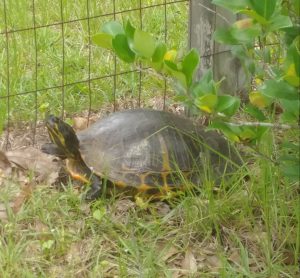
This aquatic Florida Cooter was found crossing a locals yard.
Photo: Deb Mozert
Turtles lack teeth but do have a blade like beak they can cut with. In general, smooth blades are carnivorous, serrated ones herbivorous, and their omnivorous turtles as well. Most prey are small, and most carnivores must conceal themselves to ambush their prey. Though depicted as slow animals in fairy tales and stories, turtles can be quite fast for a few seconds.
Most are diurnal (active during daylight hours) but some nocturnal activity does occur. They spend parts of their day basking on logs and other platforms to warm – turtles are ectothermic and rely on the sun for heat.
Mating occurs in the spring. And despite the fact that most are aquatic, nesting occurs on land for all. Except for a few live bearers, reptiles lay cledoic eggs (shelled) buried on dry ground. Sex is determined by the temperature of the egg in all except the softshell turtles, with eggs at 30° C or higher producing females.
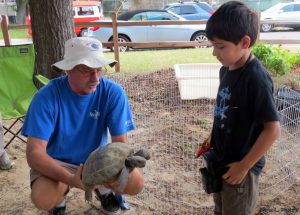
Teaching our youth about the great diversity of Florida’s turtles.
Photo: Molly O’Connor
Despite their need for warm climates, they can be found throughout the United States. But it is the warm humid southeast where they thrive. Especially the northern Gulf Coast where 60″ of rainfall each year is the norm. We will bring you an article about a new species every other week throughout this year.
Let’s Celebrate the Year if the Turtle.
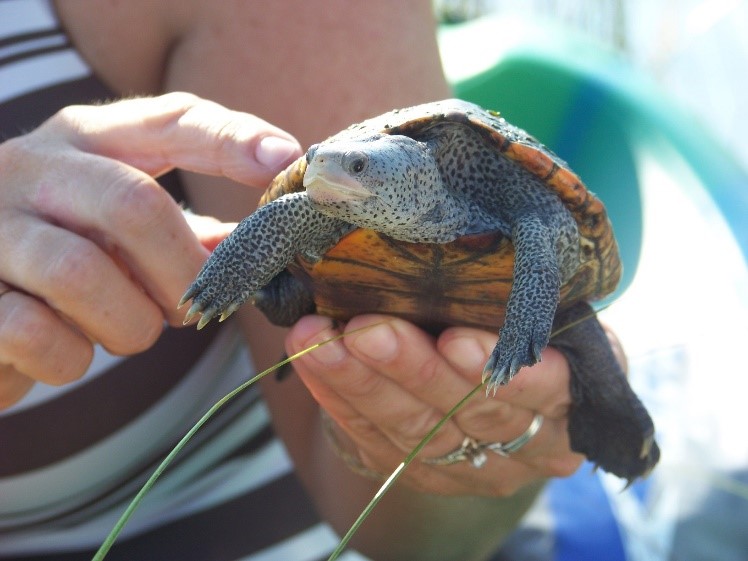
by Ray Bodrey | Apr 17, 2019
Soon, two important ecological surveys will begin in Gulf County, concerning both diamondback terrapins and mangroves.
Florida is home to five subspecies of diamondback terrapin, three of which occur exclusively in Florida. Diamondback terrapins live in coastal marshes, tidal creeks, mangroves, and other brackish or estuarine habitats. However, the diamondback terrapin is currently listed as a Species of Greatest Conservation Need (SGCN).
Diamondback terrapin populations, unfortunately, are nationally in decline. Human activities, such as pollution, land development and crabbing without by-catch reduction devices are often reasons for the decline, but decades ago they were almost hunted to extinction for their tasty meat. The recent decline has raised concern of not only federal agencies, but also organizations and community groups on the state and local levels. Diamondback Terrapin range is thought to have once been all of coastal Florida, including the Keys.
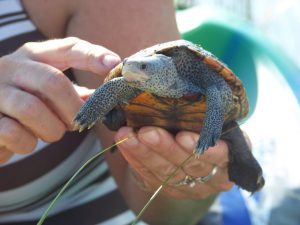
Figure 1: Diamondback Terrapin.
Credit: Rick O’Connor, UF/IFAS Extension & Florida Sea Grant, Escambia County.
Mangroves, a shoreline plant species of south Florida, are migrating north and are now being found in the Panhandle. Both red and black mangroves have been found in St. Joseph Bay. Mangroves establishment could be an important key to a healthy bay ecosystem, as a factor in shoreline restoration and critical aquatic life habitat.
Currently there is a significant data gap for both diamondback terrapin and mangrove populations. Therefore, there is a great need to conduct assessments to learn more about their geographic distribution.
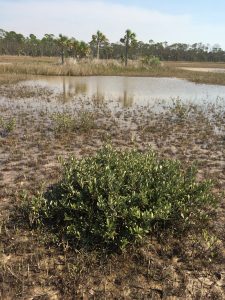
Figure 2. Black Mangrove in St. Joseph Bay.
Credit: Ray Bodrey, UF/IFAS Extension & Florida Sea Grant, Gulf County.
The Forgotten Coast Sea Turtle Center is partnering with UF/IFAS Extension & Florida Sea Grant to assist in surveying and monitoring diamondback terrapins and mangroves in St. Joseph Bay, and we need your help! UF/IFAS Extension & Florida Sea Grant Agent’s Rick O’Connor and Ray Bodrey are providing a training workshop for volunteers and coordinating surveys for St. Joseph Bay. Terrapin surveys require visiting an estuarine location where terrapin nesting sites and mangrove plants are highly probable. Volunteers will visit their assigned locations at least once a week during the months of May and June and complete data sheets for each trip. Each survey takes about two hours, and some locations may require a kayak to reach.
If you are interested in volunteering for these important projects, we will hold a training session on Monday, April 22nd at 1:00 p.m. ET at the Forgotten Coast Sea Turtle Center (located at 1001 10th Street, Port St. Joe).
For more information, please contact:
Ray Bodrey, UF/IFAS Extension Gulf County, Extension Director
rbodrey@ufl.edu
(850) 639-3200
UF/IFAS Extension is an Equal Opportunity Institution.
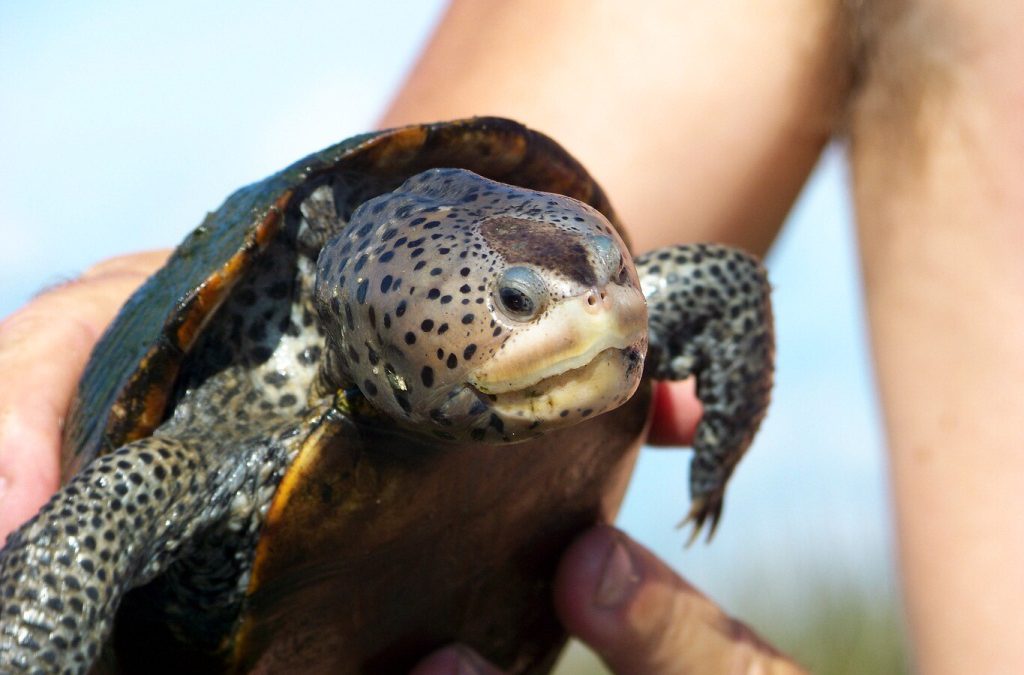
by Rick O'Connor | Mar 29, 2019
We have a lot of really cool and interesting creatures that live in our bay, but one many may not know about is a small turtle known as a diamondback terrapin. Terrapins are usually associated with the Chesapeake Bay area, but actually they are found along the entire eastern and Gulf coast of the United States. It is the only resident turtle of brackish-estuarine environments, and they are really cool looking.
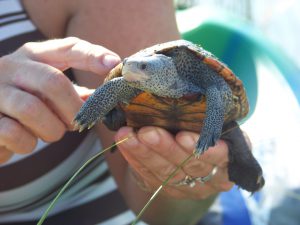
The diamond in the marsh. The diamondback terrapin.
Photo: Molly O’Connor
Terrapins are usually between five and 10 inches in length (this is the shell measurement) and have a grayish-white colored skin, as opposed to the dark green-black found on most small riverine turtles in Florida. The scutes (scales) of the shell are slightly raised and ridged to look like diamonds (hence their name). They are not migratory like sea turtles, but rather spend their entire lives in the marshes near where they were born. They meander around the shorelines and creeks of these habitats, sometimes venturing out into the seagrass beds, searching for shellfish – their favorite prey. Females do come up on beaches to lay their eggs but unlike sea turtles, they prefer to do this during daylight hours and usually close to high tide.
Most folks living here along the Gulf coast have not heard of this turtle, let alone seen one. They are very cryptic and difficult to find. Unlike sea turtles, we usually do not give them a second thought. However, they are one of the top predators in the marsh ecosystem and control plant grazing snails and small crabs. During the 19th century they were prized for their meat in the Chesapeake area. As commonly happens, we over harvested the animal and their numbers declined. As numbers declined the price went up and the popularity of the dish went down. There was an attempt to raise the turtles on farms here in the south for markets up north. One such farm was found at the lower end of Mobile Bay.
Early 20th century still found terrapin on some menus, but the popularity began to wane, and the farms slowly closed. Afterwards, the population terrapins began to rebound – that was until the development of the wire meshed crab trap. Developed for the commercial and recreational blue crab fishery, terrapins made a habitat of swimming into these traps, where they would drown. In the Chesapeake Bay area, the problem was so bad that excluder devices were developed and required on all crab traps. They are not required here in Florida, where the issue is not as bad, but we do have these excluders at the extension office if any crabber has been plagued with capturing terrapins. Studies conducted in New Jersey and Florida found these excluder devices were effective at keeping terrapins out of crab traps but did not affect the crab catch itself. Crabs can turn sideways and still enter the traps.
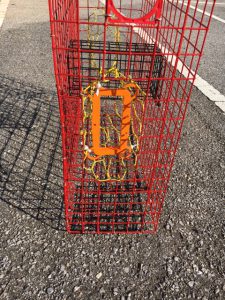
This orange plastic rectangle is a Bycatch Reduction Device (BRD) used to keep terrapins out of crab traps – but not crabs.
Photo: Rick O’Connor
Another 20th century issue has been nesting predation by raccoons. As we began to build roads and bridges to isolated marsh islands in our bays, we unknowingly provided a highway for these predators to reach the islands as well. On some islands, raccoons depredated 90% of the terrapin nests. Today, these turtles are protected in every state they inhabit except Florida. Though there is currently no protection for the terrapin itself in our state, they do fall under the general protection for all riverine turtles; you may only possess two at any time and may not possess their eggs.
Some scientists have discussed identifying terrapins as a sentinel species for the health of estuaries. Not having terrapin in the bay does not necessarily mean the bay is unhealthy, but the decline of this turtle (or the blue crab) could increase the population of smaller plant grazing invertebrates they eat throwing off the balance within the system.
Sea Grant trains local volunteers to survey for these creatures within our bay area. Trainings usually take place in April and surveys are conducted during May and June. This year we will be training volunteers in the Perdido area on April 10 at the Southwest Branch of the Pensacola Library on Gulf Beach Highway. That training will begin at 10:00 AM. For Pensacola Beach the training will be on April 15 at the Navarre Beach Sea Turtle Conservation Center on Navarre Beach. That training will begin at 9:00 AM. A third training will take place on April 22 at the Port St. Joe Sea Turtle Center in Port St. Joe. For more information on diamondback terrapins contact me at the Escambia County Extension Office – (850) 475-5230 ext. 111.
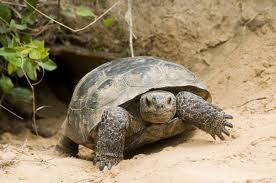
by Rick O'Connor | Jun 22, 2018
Just a decade ago, few people would have known what a gopher tortoise was and would have hard time finding one. But today, because of the protection they have been afforded by the state, they are becoming more common. This is certainly an animal you might see visiting one of our state parks.
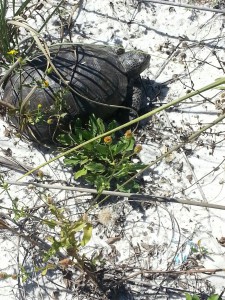
This gopher tortoise was found in the dune fields on a barrier island – an area where they were once found.
Photo: DJ Zemenick
The gopher tortoise is one of only two true land dwelling turtles in our area and is in a family all to its own. They are miners, digging large burrows that can extend up to a depth of 7 feet and a length of 15 feet underground. However, tortoises are not very good at digging up towards the surface, so there is only the one entrance in and out of the burrow. The burrow of the tortoise can be distinguished from other burrowing animals, such as armadillos, in that the bottom line of the opening is flat – a straight line – and the top is domed or arched shaped; mammalian burrows are typically round – circular. Tortoise burrows also possess a layer of dirt tossed in a delta-shaped fan out away from the entrance (called an apron). Many times the soil is from deeper in the ground and has a different color than the soil at the surface. The general rule is one burrow equals one tortoise, though this is not always true. Some burrows are, at times, shared by more than one and some may not be occupied at all. Many field biologists will multiple the number of burrows by 0.6 to get an estimate of how many tortoises there are in the area.
The tortoise itself is rather large, shell lengths reaching 15 inches. They can be distinguished from the other land dwelling turtle, the box turtle, by having a more flattened dome to the shell and large elephant like legs. The forelimbs are more muscular than the hind and possess large claws for digging the burrow. They are much larger than box turtles and do not have hinged plastrons (the shell covering the chest area) and cannot close themselves up within the shell as box turtles can. Tortoises prefer dry sandy soils in areas where it is more open and there are plenty of young plants to eat; box turtles are fans of more dense brush and wooded areas.
Tortoises spend most of the day within their burrows – which remain in the 70°F range. Usually when it is cooler, early morning or late afternoon, or during a rain event – the tortoises will emerge and feed on young plants. You can see the paths they take from their burrows on foraging trips. They feed on different types of plants during different type times of the year to obtain the specific nutrients. There are few predators who can get through the tough shell, but they do have some and so do not remain out for very long. Most people find their burrows, and not the tortoise. You can tell if the burrow has an active tortoise within by the tracks and scrap marks at the entrance. Active burrows are “clean” and not overgrown with weeds and debris. Many times, you can see the face of the tortoise at the entrance, but once they detect you – they will retreat further down. Many times a photo shot within a burrow will reveal the face of a tortoise in the picture. There is a warning here though. Over 370 species of creatures use this burrow to get out of the weather along with the tortoise – one of them is the diamondback rattlesnake. So do not stick your hand or your face into the entrance seeking a tortoise.
Most of the creatures sharing the burrow are insects but there are others such as the gopher frog and the gopher mouse. One interesting member of the burrow family is the Eastern Indigo Snake. This is the largest native snake to North America, reaching a length of eight feet, and is a beautiful iridescent black color. It is often confused with the Southern Black Racer. However, the black racer is not as long, not as large around (girth), and possess a white lower jaw instead of the red-orange colored one of the indigo. The indigo is not dangerous at all, actually it feeds on venomous snakes and it is a good one to have around.
Federal and state laws protect the indigo, as with the gopher frog and mouse. All of these animals have declined in number over the past few decades. This is primarily due to loss of the needed gopher burrows, which have declined because the tortoises have declined, and this is due to habitat loss and harvesting. Again, tortoises like dry sandy soils for digging burrows. They prefer wooded areas that are more open and allow the sun to reach the forest floor where young grasses and flowers can grow. The longleaf pine forest is historically the place to find them but they are found in coastal areas where such open wooded areas exist. The lack of prescribe burning has been a problem for them. Florida is the number one state for lightning strikes. Historically, lightning strikes would occasionally start fires, which would burn the underbrush and allow grasses to grow. In recent years, humans have suppressed such fires, for obvious reasons, and the tortoise community has suffered because of it. Therefore, we now have prescribe fire programs on most public lands in the area. This has helped to increase the number of tortoises in the area and your chance of seeing one.
All of the members of the tortoise community are still protected by state, and – in the case of the indigo snake – federal law, so you must not disturb them if seen. Photos are great and you should feel lucky to have viewed one. Though they could be found anywhere where it is high, dry, and somewhat open – the state and national parks are good places to look.
Reference
Meylan, P.A. (Ed.). 2006. Biology and Conservation of Florida Turtles. Chelonian Research Monographs No. 3, 376 pp.





















